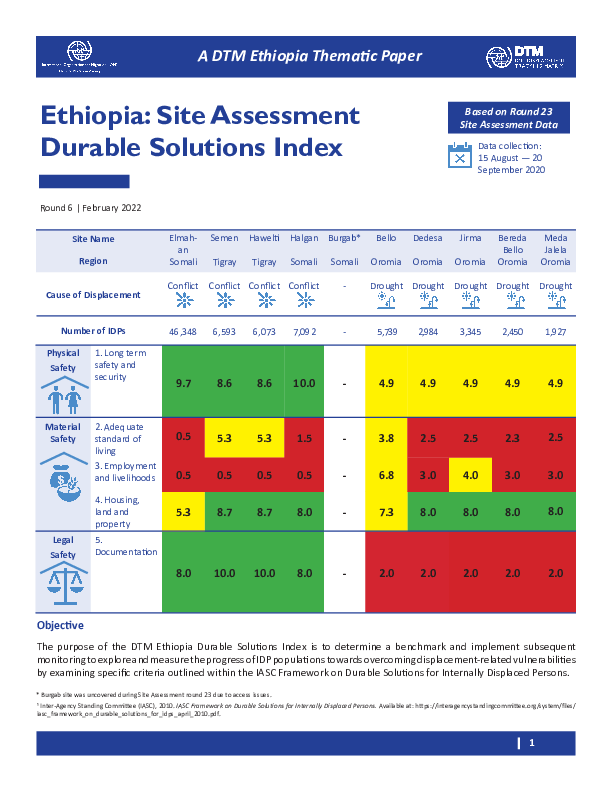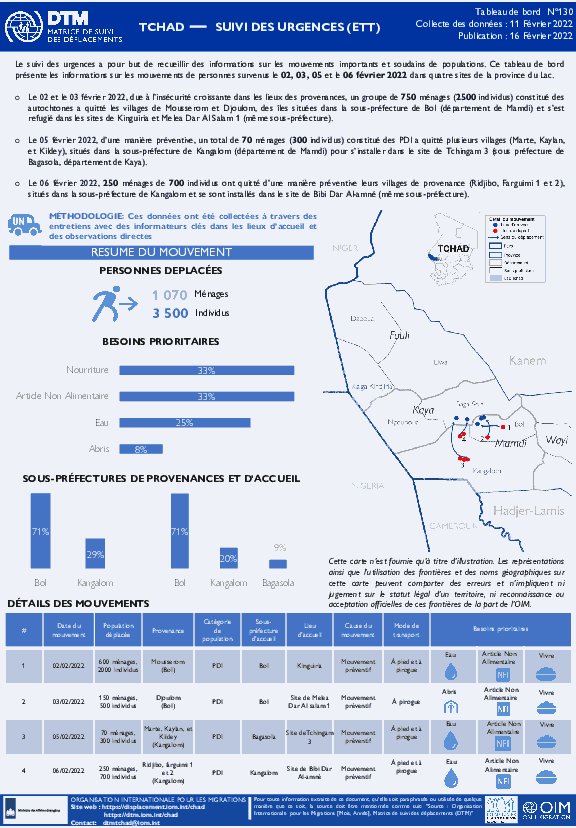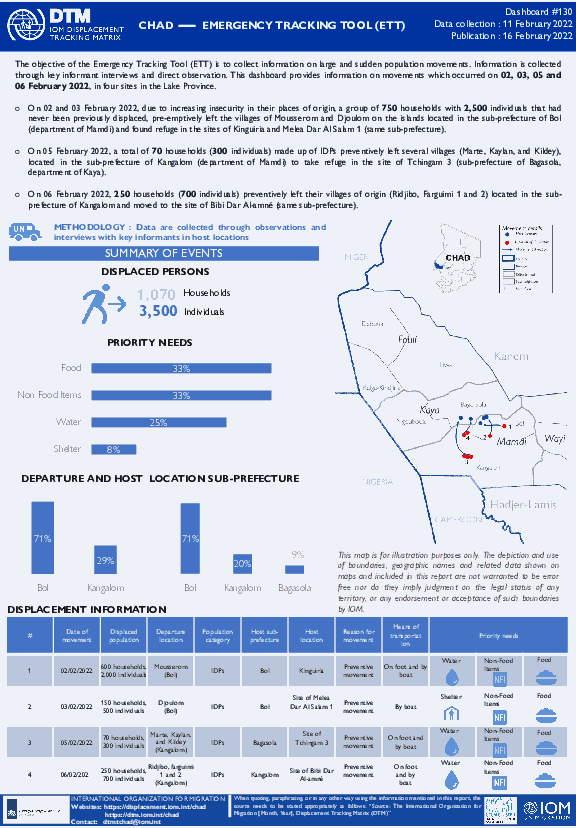-
Countries
-
Data and Analysis
-
Special Focus
-
Crisis Responses

Contact
DTM Mali, DTMMali@iom.int
Language
English
Location
Mali
Period Covered
Jan 01 2022
Jan 31 2022
Activity
- Survey
- Flow Monitoring Survey
- Flow Monitoring
In order to gain a better understanding of mobility flows and trends, the International Organization for Migration (IOM) has implemented the Displacement Tracking Matrix’s Flow Monitoring (FM) tool at key transit points across the region. Flow Monitoring activities are conducted in close cooperation with national and local authorities as well as local partners. The Flow Monitoring tool consists of two main components: the Flow Monitoring Registry (FMR), which captures key data on the volume, origin, destination and mode of travel of mobility flows, and the Flow Monitoring Survey (FMS), individual surveys conducted with travellers to gather detailed information about the profiles, migration experience and intentions of migrants. Through these activities, the Flow Monitoring tool collects data on migration flows and trends, traveller profiles, migration journeys, and intentions of migrants, so as to obtain a better understanding of mobility.
In Mali, DTM conducts Flow Monitoring activities at seven Flow Monitoring Points (FMPs) located across six regions, in order to foster a better understanding of the numbers, trends, profiles, and journeys of migration flows crossing these points.
This reports presents data collected through the Flow Monitoring Registry in January 2022.

Contact
DTM Mali, DTMMali@iom.int
Language
French
Location
Mali
Period Covered
Jan 01 2022
Jan 31 2022
Activity
- Survey
- Flow Monitoring Survey
- Flow Monitoring
Afin de mieux comprendre les mouvements et tendances migratoires, l’OIM, à travers la Matrice de suivi des déplacements (Displacement Tracking Matrix, DTM), met en œuvre l’activité de Suivi des flux de populations (Flow Monitoring, FM).
Le suivi des flux, qui est mis en œuvre en étroite collaboration avec les autorités et des partenaires nationaux et locaux, est composé de deux outils: l’enregistrement des flux (Flow Monitoring Registry, FMR), qui recueille des données clés sur l’ampleur, la provenance, la destination et les modalités des flux de mobilité, et les enquêtes individuelles (Flow Monitoring Survey, FMS), conduites auprès des voyageurs afin d’obtenir des informations sur les profils, parcours migratoires, et intentions des migrants. Le suivi des flux de populations récolte ainsi des données sur les flux et tendances migratoires, les profils des voyageurs et les parcours et intentions des migrants, afin de fournir une meilleure compréhension des mobilités.
Au Mali, la DTM recueille des données au niveau de 7 Points de suivi des flux (Flow Monitoring Points, FMP), répartis dans 6 régions afin d’obtenir une meilleure compréhension de l’ampleur, des tendances, des caractéristiques socio-démographiques et des parcours des flux de voyageurs traversant ces différents points.
Ce rapport présente les données recueillies dans le cadre des activités d’enregistrement des flux durant le mois de janvier 2022.

Contact
DTM Ethiopia, SLOAddisAbabaDTM@iom.int
Language
English
Location
Ethiopia
Period Covered
Aug 15 2020
Sep 20 2020
Activity
- Site Assessment
- Mobility Tracking
The DTM Ethiopia Village Assessment Survey Durable Solutions Index Report measures the progress of returning IDP populations towards overcoming displacement-related vulnerabilities by examining specific criteria outlined within the IASC Framework on Durable Solutions for Internally Displaced Persons. The composite index is made up of 57 indicators from DTM Ethiopia's Village Assessment Survey and treated as sub-criteria in measuring 6 criteria of the IASC Framework. In this report, the index is applied to 10 villages to measure progress towards overcoming displacement-related vulnerabilities.

Contact
DTM Ethiopia, SLOAddisAbabaDTM@iom.int
Language
English
Location
Ethiopia
Period Covered
Aug 15 2020
Sep 20 2020
Activity
- Site Assessment
- Mobility Tracking
The DTM Ethiopia Site Assessment Durable Solutions Index Report measures the progress of IDP populations towards overcoming displacement-related vulnerabilities by examining specific criteria outlined within the IASC Framework on Durable Solutions for Internally Displaced Persons. The composite index is made up of 24 indicators from DTM Ethiopia's Site Assessment and treated as sub-criteria in measuring the 5 core criteria of the IASC Framework. In this report, the index is applied to 20 sites to measure progress towards overcoming displacement-related vulnerabilities.

Contact
DTM Nigeria, AllUsersInDTMNigeria@iom.int
Language
English
Location
Nigeria
Period Covered
Feb 07 2022
Feb 13 2022
Activity
- Event Tracking
- Mobility Tracking
Between 7th and 13th February 2022, a total of 1,678 movements were recorded in Adamawa and Borno States. The recorded movements consisted of 1,329 arrivals and 349 departures. Arrivals were recorded at locations in Askira/Uba, Bama, Biu, Gwoza, Kala/Balge, Munguno and Ngala Local Government Areas (LGAs) of the most conflict-affected State of Borno and in Girei, Gombi, Hong, Lamurde, Maiha, Michika, Mubi South, Yola North and Yola South LGAs of Adamawa State.
Departures were recorded in Askira/Uba LGA of Borno, and in Gombi, Hong, Maiha, Mubi South, Song and Yola North LGAs of Adamawa State.

Contact
DTM Tchad, dtmtchad@iom.int
Language
French
Location
Chad
Snapshot Date
Feb 11 2022
Activity
- Event Tracking
- Mobility Tracking
Le suivi des urgences a pour but de recueillir des informations sur les mouvements importants et soudains de populations. Ce tableau de bord présente les informations sur les mouvements de personnes survenus le 02, 03, 05 et le 06 février 2022 dans quatre sites de la province du Lac.
Le 02 et le 03 février 2022, due à l’insécurité croissante dans les lieux des provenances, un groupe de 750 ménages (2500 individus) constitué des autochtones a quitté les villages de Mousserom et Djoulom, des îles situées dans la sous-préfecture de Bol (département de Mamdi) et s’est refugié dans les sites de Kinguiria et Melea Dar Al Salam 1 (même sous-préfecture).
Le 05 février 2022, d’une manière préventive, un total de 70 ménages (300 individus) constitué des PDI a quitté plusieurs villages (Marte, Kaylan, et Kildey), situés dans la sous-préfecture de Kangalom (département de Mamdi) pour s’installer dans le site de Tchingam 3 (sous préfecture de Bagasola, département de Kaya).
Le 06 février 2022, 250 ménages de 700 individus ont quitté d’une manière préventive leurs villages de provenance (Ridjibo, Farguimi 1 et 2), situés dans la sous-préfecture de Kangalom et se sont installés dans le site de Bibi Dar Al-amné (même sous-préfecture).

Contact
DTM Chad, dtmtchad@iom.int
Language
English
Location
Chad
Snapshot Date
Feb 11 2022
Activity
- Event Tracking
- Mobility Tracking
The objective of the Emergency Tracking Tool (ETT) is to collect information on large and sudden population movements. Information is collected through key informant interviews and direct observation. This dashboard provides information on movements which occurred on 02, 03, 05 and 06 February 2022, in four sites in the Lake Province.
On 02 and 03 February 2022, due to increasing insecurity in their places of origin, a group of 750 households with 2,500 individuals that had never been previously displaced, pre-emptively left the villages of Mousserom and Djoulom on the islands located in the sub-prefecture of Bol (department of Mamdi) and found refuge in the sites of Kinguiria and Melea Dar Al Salam 1 (same sub-prefecture).
On 05 February 2022, a total of 70 households (300 individuals) made up of IDPs preventively left several villages (Marte, Kaylan, and Kildey), located in the sub-prefecture of Kangalom (department of Mamdi) to take refuge in the site of Tchingam 3 (sub-prefecture of Bagasola, department of Kaya).
On 06 February 2022, 250 households (700 individuals) preventively left their villages of origin (Ridjibo, Farguimi 1 and 2) located in the sub-prefecture of Kangalom and moved to the site of Bibi Dar Al-amné (same sub-prefecture).

Contact
DTM Sudan; dtmsudan@iom.int
Language
English
Location
Sudan
Snapshot Date
Jan 25 2022
Activity
- Event Tracking
- Mobility Tracking
The DTM Emergency Event Tracking (EET) is deployed to track sudden displacement and population movements, provide more frequent updates on the scale of displacement, and quantify the affected population when needed. As a subcomponent of the new Mobility Tracking methodology in Sudan (Round Three), and activated on a need basis, EET utilises a broad network of key informants to capture best estimates of the affected population presence per location – a useful tool for humanitarian response planning and design.

Contact
DTMcovid19@iom.int
Language
English
Location
Global
Snapshot Date
Feb 07 2022
Activity
- Other
The current outbreak of COVID-19 has affected global mobility in the form of various travel disruptions and restrictions. To better understand how COVID-19 affects global mobility, DTM has developed a COVID-19 database mapping the different restrictions to provide a global overview. For this, DTM uses the IATA site as the primary source of restrictions with the information reported per country and territory, and to the country of application.
Data collected includes:
- Date of restriction
- Country, territory or area of restriction
- Countries, territories or areas on which restrictions were imposed
- Type of restriction- total restriction, or conditional restriction – such as medical/ and or visa restriction
This DTM COVID-19 Travel Restrictions Output presents an analysis based on country imposing, the country being imposed upon, and the aggregation of the restriction type. The aim of the data analysis is to provide an overview of the COVID-19 outbreak on global mobility and to help identify and develop responses.
During the COVID-19 pandemic, IOM's Displacement Tracking Matrix (DTM), in collaboration with the World Health Organization (WHO), monitors the movements to and from Nigeria's Adamawa and Borno States in north-east Nigeria. Assessments are conducted at Points of Entry located along the border with Cameroon.
During the period 05 - 11 February 2022, 225 movements were observed at three Points of Entry in Borno state. Of the total movements recorded, 100 were incoming from the Far North Region in Cameroon, eight were incoming from Ndjamena in Chad, and 16 were incoming from Bol, also in Chad. Ninety-five outgoing movements were recorded from Borno State to the Far North
Region in Cameroon, four outgoing movements to Bol in Chad and two outgoing movements to Ndjamena in Chad

